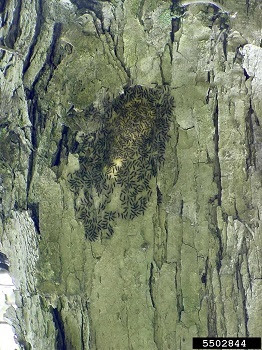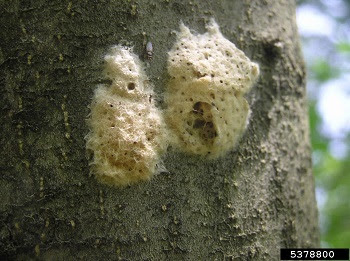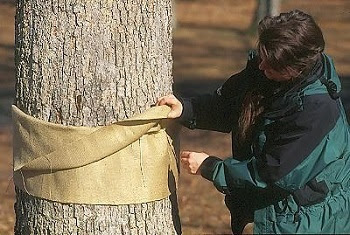| May 2, 2022
Contact: Cheryl Nelson 231-287-1714, or Joanne Foreman 517-284-5814
While the new name still may be unfamiliar, the invasive spongy moth, formerly referred to as gypsy moth, is well known across Michigan. In its caterpillar life stage, the insect is a voracious leaf eater.
 Spongy moth populations were high last year across Lower Michigan, and many people are wondering whether the nuisance caterpillars will be plaguing their backyard events again in 2022. To find out, NotMISpecies webinar hosts brought together experts to share their insights on the invasive moth’s history in Michigan and the U.S. and what to expect this year. Spongy moth populations were high last year across Lower Michigan, and many people are wondering whether the nuisance caterpillars will be plaguing their backyard events again in 2022. To find out, NotMISpecies webinar hosts brought together experts to share their insights on the invasive moth’s history in Michigan and the U.S. and what to expect this year.
Panelists Dr. Deborah McCullough from Michigan State University, Dr. Steven Katovich of the U.S. Department of Agriculture’s Forest Service, Susie Iott of the Michigan Department of Agriculture and Rural Development and James Wieferich of the Michigan Department of Natural Resources together represent nearly 100 years of knowledge about the pest. Following their April 14 session, they responded to participants’ questions in a written document.
Key points from the presentation and their answers to the most-asked questions about spongy moth are summarized here. |
What is the forecast for 2022?
Based on recent aerial survey data, much of northern Lower Michigan has experienced two or three years of defoliation, which typically marks the end of an outbreak cycle. Egg mass surveys in the fall of 2021 confirmed that many areas in Michigan should expect a collapse of spongy moth activity in much of lower Michigan – meaning far fewer caterpillars this year. However, a few areas like Jackson County and parts of southwest Lower Michigan had large, healthy egg masses and may have high density populations again this summer.
What causes population crashes?
The last large-scale spongy moth outbreak occurred in Michigan from about 1992 to 1996. Since then, localized areas have experienced occasional outbreaks. Suppression efforts in the 1990s have continued to keep spongy moth populations largely in check while naturalizing infestations into Michigan’s forests and urban forest ecosystems.
In 1991, Entomophaga maimaiga, a fungal pathogen found to be killing spongy moth caterpillars in the northeastern states, was deployed in Michigan. This fungus proved an effective biological control, remaining in the soil from year to year and infecting spongy moth caterpillars that come in contact with the fungal spores. Moist soils help to activate the fungus, enabling spores to disperse and affect spongy moth populations. Caterpillars affected by the E. maimaiga fungus remain attached to tree trunks and hang straight down.
 Nucleopolyhedrosis virus occurs naturally in all spongy moth populations. NPV spreads through contact between caterpillars during outbreaks, causing a population crash. To determine whether NPV is at work in a certain location, look for dead caterpillars attached to tree trunks in an upside-down “V” position. Nucleopolyhedrosis virus occurs naturally in all spongy moth populations. NPV spreads through contact between caterpillars during outbreaks, causing a population crash. To determine whether NPV is at work in a certain location, look for dead caterpillars attached to tree trunks in an upside-down “V” position.
Both the NPV virus and E. maimaiga fungus can affect the same population, and dead NPV and fungus-killed caterpillars can be on the same tree.
These natural enemies of the spongy moth are now well-established across Michigan and are actively reducing populations. To date, these pathogens typically have limited the size and length of outbreaks to a couple years, eliminating the need for spray programs. |
Today, spongy moth outbreaks are cyclical, peaking approximately every seven to 10 years. In these years, the virus and the fungal disease are spread more easily through dense populations, eventually causing a crash.
Do these controls affect other species?
NPV and the fungal disease have important benefits – they are specific to spongy moth populations and do not affect people, pets or beneficial insects like pollinators or insect predators. In addition, they remain in the environment, continuing to help control spongy moth populations every year.
The spongy moth NPV pathogen (virus) is species-specific. It arrived with spongy moth and has driven population dynamics for over 150 years. In lab tests, the E. maimaiga fungus was able to infect a few other species, but this has not been observed outside the lab – the timing and behavior of spongy moth caterpillars result in fungal infection in spring. Native species either can’t be infected, are not present until later in the year or have other behavioral patterns that prevent them from becoming infected.
What about spray programs?
The State of Michigan does not have a statewide spray program. Spongy moth is a naturalized pest in Michigan now. However, a few areas have long-standing millages in place to help survey and spray residential areas when needed.
Outbreaks will continue to occur occasionally in local areas and, yes, every now and then we will have extensive outbreaks like the current one. While an outbreak is not pleasant for people in an affected area, it is rarely a problem for healthy trees and forests.
What can I do if spongy moth returns this year?
 First, check the spongy moth forecast for your neighborhood by looking for healthy egg masses now, before leaves expand. Healthy egg masses are larger than a quarter in size, tan or brownish in color and firm to the touch. Few egg masses and/or small (nickel-size) egg masses indicate the population is collapsing because the NPV pathogen is increasing. Old, no longer productive egg masses, like those in the above photo, are often abundant after an outbreak year and should not be counted. These masses are usually whiteish in color, may be falling apart and may have pin-size holes in the mass. An abundance of healthy egg masses suggests a heavy infestation of spongy moth caterpillars this season. First, check the spongy moth forecast for your neighborhood by looking for healthy egg masses now, before leaves expand. Healthy egg masses are larger than a quarter in size, tan or brownish in color and firm to the touch. Few egg masses and/or small (nickel-size) egg masses indicate the population is collapsing because the NPV pathogen is increasing. Old, no longer productive egg masses, like those in the above photo, are often abundant after an outbreak year and should not be counted. These masses are usually whiteish in color, may be falling apart and may have pin-size holes in the mass. An abundance of healthy egg masses suggests a heavy infestation of spongy moth caterpillars this season. |
Before choosing a control method, remember that you will not be able to eliminate all the caterpillars – the goal is to reduce the density of caterpillars around your house.
- Scraping: If healthy egg masses are found on trees, buildings or outdoor furniture around the home, act now, as egg masses can start hatching anytime! Use a scraper or hard, plastic card to scrape egg masses into a container of soapy water. Let them soak overnight, then bag and dispose of them. Alternately, egg masses can be placed in a fire and burned.

- Banding: Cut a band of burlap 18 inches wide and long enough to go around the tree trunk and overlap a bit. Tie a string around the center of the band to make a two-layered skirt around the trunk. When caterpillars climb trees daily to feed, they will get caught in the band. Scrape them into a bucket of soapy water to kill them.
- Spraying: To address an infestation in a handful of individual trees, homeowners can purchase a spray containing Bacillus thuringiensis var. kurstaki, a bacterium that naturally occurs in the soil but can be lethal to certain caterpillars and moths. The best time to spray is when caterpillars are small, usually mid-May through early June. Be sure to choose an Environmental Protection Agency-registered pesticide and apply it according to label directions. Remember, there is no good reason to spray woodlots or forested areas. Healthy trees and forests can withstand periodic infestations.
|
To learn more about spongy moth caterpillars and options for residents living in an outbreak area, visit the MSU IPM Gypsy Moth website. The bulletin Btk: One management option for Lymantria dispar offers detailed information about Btk management for spongy moth.
Check for upcoming NotMiSpecies webinars and watch past, recorded webinars – on everything from spongy moth to invasive carp – at Michigan.gov/Invasives. |